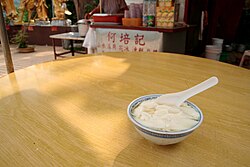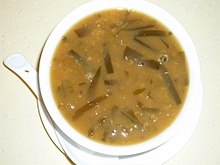 Tofu tong sui at 10,000 Buddhas Monastery | |
| Type | Soup or custard |
|---|---|
| Course | Dessert |
| Place of origin | China |
| Tong sui | |||||||||||||||
|---|---|---|---|---|---|---|---|---|---|---|---|---|---|---|---|
| Chinese | 糖水 | ||||||||||||||
| Literal meaning | sugar water | ||||||||||||||
| |||||||||||||||
| Tian tang | |||||||||||||||
| Chinese | 甜湯 | ||||||||||||||
| Literal meaning | sweet soup | ||||||||||||||
| |||||||||||||||




Tong sui (Chinese: 糖水; lit. 'sugar water'), also known as tim tong, is a collective term for any sweet soup or custard served as a dessert typically at the end of a meal in Chinese cuisine. Tong sui originated in the Lingnan region of China, including Guangdong, Guangxi, Hainan, Hong Kong, Macau, and some parts of other provinces in China.[1][2] Therefore, in the narrow sense, the term tong sui is used to refer to soupy desserts from Lingnan, while occasionally it is also used in the broad sense, referring to any soupy dessert in Chinese-speaking regions.[3]
A large variety of tong sui can be found in specialty stores dedicated to these desserts, called tong sui stores. Today, they have gained prominence in other parts of China and overseas. People can find tong sui stores in various parts of Canada, Australia, and the United States, showcasing the global appeal of these treats.
History[edit]

The origin of Tong sui is hard to track, and its development in different regions also varied.
One main theory is that the climate in Lingnan is hot and humid,[4] and Traditional Chinese Medicine believes this weather makes people catch dampness and internal heat, and sugar has the effect of clearing dampness and internal heat. Also, the Pearl River Delta region is a subtropical area with abundant sugarcane resources,[5] so people in these areas have a history of "boiling sugar water" for health benefits.[6]
In Guangzhou, Guangdong, there were Tong sui stores in the early 20th century. Most of them sold black sesame soup, mung bean soup, almond soup, and sweet potato soup at first. As the price of the products was low, it gained popularity among the people, and the industry developed well. Later, in the 1930s, dairy-based tong sui, such as steamed milk curd and ginger milk curd, appeared on the market and were fashionable.[7]
Tong sui shops in Hong Kong mainly originated from the postwar period. Chinese migrants brought their hometown sweet soups to Hong Kong, such as red bean soup from Guangzhou and tang yuan from Shanghai. Newcomers sold tong sui in newly opened street side food stalls and Chinese tea house. During the 1980s to 1990s, Hong Kong's economy developed rapidly and living standards rose. Western desserts and sweet soups were imported to Hong Kong by Western hotels or cooks who had studied in the West. Under Western influence, people started using fresh fruits to create new-style tong sui such as tapioca pudding. Many Chinese herbal tea shops like Hui Lau Shan transformed into tong sui shops.[8] In the 21st century, chain tong sui shops have become more prominent and recommended as tourist attractions by The Hong Kong Tourism Board.
Traditional tong sui[edit]

Historically, the basic ingredients of traditional sweet soups are beans, milk, and fruits.[9] The desserts and sweet soups provided in the menus of the traditional tong sui shops are mainly the Chinese-style sweet soups. Staples like red bean soup and sweet almond soup are common types of sweet soups sold in the ordinary tong sui shops.[10]
Common varieties[edit]
| English name | Chinese name | Description |
|---|---|---|
| Black sesame soup | 芝麻糊; zi1 maa4 wu4*2 | Ground black sesame seeds are traditionally cooked with water and rock sugar. Chinese herbs are sometimes added to enhance the flavor and aroma. The instant black sesame powder sold in Asian supermarkets is usually sweetened. It requires the addition of hot water and mixing in the serving bowl, after which it should be left for 15 minutes before serving. |
| Doufuhua[11] | 豆花; dòuhuā or 豆腐花; dau6 fu6 faa1 | Tofu pudding, add a small amount of salt or gypsum condensed into soy milk to form a more tender semi-liquid tofu with sweet syrup served in a separate bowl. |
| Egg tong sui | 鸡蛋糖水; 雞蛋糖水; gai1 daan2 tong4 seoi2 | popular in Hong Kong and southern China. |
| Got fan soup | 葛粉汤; 葛粉湯; got3 fan2 tong1 | kudzu soup. |
| Guilinggao | 龜苓膏; gwai1 ling4 gou1 | made from three-lined box turtle. |
| Hasma | 雪蛤; syut3 gaap3 | A dessert made of dried frog fallopian tubes with supposed health benefits. |
| Purple rice porridge | 紫米露; zi2 mai5 lou6 | A dessert made of thick boiled black rice mixed with coconut juice. Sago, red beans, and taro are often added on top. |
| Red bean soup | 红豆汤; 紅豆湯; hóngdòu tāng or 红豆沙; 紅豆沙; hung4 dau2 saa1 | Cooked and served exactly like mung bean soup & paste. Red bean soup is normally pre-boiled to soften the skin by leaving it in hot water for one hour. Then cook in water for 20–30 minutes until the beans rupture. Sugar or rock sugar is then added and cooked for another 20–30 minutes until the bean texture becomes sandy. As for red bean paste, the skin is removed before cooking. Chinese herbs may be added to enhance the flavor and taste. |
| Sai mai lo or Sago | 西米露; sai1 mai5 lou6 | A dessert soup of pearl tapioca, coconut and evaporated milk. |
| Mung bean soup | 绿豆汤; 綠豆湯; lǜdòu tāng or 绿豆沙; 綠豆沙; luk6 dau6 saa1 | Made from mung beans and cooked exactly like red bean soup/paste, sometimes also served with seaweed. |
| Six flavors soup | 六味汤; 六味湯; liùwèi tāng | A sweet curative soup made for hot summer days, one of many "numbered" medicinal soups. |
| Peanut paste soup | 花生糊; huāshēng hú | Like black sesame paste, peanut paste is a ground peanut powder cooked with syrup and water. Instant peanut paste powder sold in Asian supermarkets are usually sweetened roasted peanut powder or flour, that only requires hot water to be served. |
| Steamed egg custard | 炖蛋; 燉蛋; dan6 daan2 | |
| Steamed milk custard | 炖奶; 燉奶; dan6 naai5 | |
| Sweet potato soup | 番薯糖水; faan1 syu4 tong4 seoi2 | Peeled sweet potato, normally cut into smaller pieces cooked/ boiled with syrup and water. |
| Sweet almond soup | 杏仁糊; hang6 jan4 wu4 | Ground almond powder that is cooked with sugar and water. Instant almond powder sold in Asian supermarkets are usually sweetened raw almond flour or powder, requires minimal cooking with boiling water or to be served after mixing with hot water for 15 minutes. |
| Sweet walnut soup | 核桃糊; hat6 tou4 wu4 or 合桃糊; hap6 tou4 wu4 | Ground walnut powder that is cooked with sugar and water, sometimes milk. Similar to Sweet almond soup, instant walnut powder is sold in Asian supermarkets as well. |
| Tofu skin egg tong sui | 腐竹鸡蛋糖水; 腐竹雞蛋糖水; fu6 zuk1 gai1 daan2 tong4 seoi2 | Made of four ingredients: tofu skin, eggs, sugar and water. Soften the dry tofu skin by soaking it in water first, boil it with sugar and water, add boiled eggs before serving. Sometimes, boiled ginkgo nuts are added. |
| Chiu-chow style mung bean sweet soup | 绿豆爽、绿豆蒜(台語:li̍k-tāu-suàn)、豆爽(tau suan) | It is originally from Chiu-chow (Chaozhou), but later spread to other regions such as Singapore, Taiwan, and Malaysia. Each region has its own variation. It is made of skinless mung beans, sugar and arrowroot starch or glutinous rice.[12] |
| Sophora flower noodle soup | 槐花粉糖水 | Sophora flower noodle soup is a unique tong sui from Guangxi. The sophora flower noodle is made by filtering the rice pulp made from rice and sophora flower pulp through a funnel to form the noodle shape in the water. People add chilled sugar water to the sophora flower noodles to make it a tong sui.[13][14] |
| Hainan style ching bo leung | 清补凉
(Ching bo leung / Qing bu liang) |
The name of the dessert means "refreshing, nourishing, cool", which speaks for itself. It is an iced dessert typically topped with mung bean, pearl barley, red jujube, seasonal fruits, syrup, ice, and sometimes milk.[15] |
| Cha cha | 喳咋 | This is a dessert from Macau. It is said that the dessert was invented by Portuguese soldiers stationed in Macau who used to cook various kinds of beans in a pot of sugar water for lunch. The dish was initially made of various kinds of beans, such as red beans, green beans, eyebrow beans, red kidney beans, triangle beans, etc. Later on, taro and sago were also added.[16] |
| Mango pomelo sago | 杨枝甘露 | A dessert from Hong Kong made of diced mango, sliced pomelo, sago, coconut milk, evaporated milk and milk. This dessert was said to be invented by Lei Garden, a famous Cantonese restaurant in Hong Kong.[17] |
See also[edit]
Sources[edit]
- ^ 【食力】楊枝甘露原來是香港首創?盤點8大港式糖水經典味. Yahoo News (in Chinese). Retrieved 2023-04-06.
- ^ 钟仁, 袁 (1998). 岭南文化. 沈阳: 辽宁敎育出版社.
- ^ 糖水世界的沧海遗珠,原来在这里. 知乎专栏 (in Chinese). Retrieved 2023-04-06.
- ^ 舌尖上的气象之口味篇. www.cma.gov.cn. Retrieved 2023-04-06.
- ^ 廣東史誌 (in Chinese). 《廣東史志》編輯室. 1993.
- ^ 林乃燊 (2010). 岭南饮食文化 (in Chinese). 广东高等教育出版社. ISBN 978-7-5361-3820-9.
- ^ [食在民间·糖水] 岭南之水,天赋之糖,桂圆莲子话姻缘. 南都广州. 2007-03-19. Archived from the original on 2014-09-12.
- ^ Dessert chain offers place to chill out. South China Morning Post. Retrieved 24/3/2014
- ^ 感受舌尖上的溫暖 香港糖水的'甜秘密'. Chinanews. Retrieved 24/3/2014 Archived 2014-03-25 at the Wayback Machine
- ^ 新舊糖水舖 左右互搏生意經. The Sun. Retrieved 19/3/2014
- ^ 教育部《國語辭典簡編本》2021. dict.concised.moe.edu.tw. Retrieved 2019-11-19.
- ^ 最屏食 (2022-06-30). 綠豆「蒜」到底是什麼?全球化糖水、在地化口味,解析綠豆蒜的跨國身世之謎. 微笑台湾.
- ^ 廣西的槐花粉是一種什么小吃? (in Chinese (Taiwan)). Retrieved 2023-04-06.
- ^ 跳海大院_ (2021-08-03). 广西糖水、广式糖水、化州糖水,谁才是最强王者. k.sina.cn. Retrieved 2023-04-06.
- ^ "Coconut Qing Bu Liang from Hainan is a Must-Try Summer Dessert". The World of Chinese. Retrieved 2023-04-06.
- ^ 港式糖水: 喳咋的由來? - 可可與海 (@mtlover1201). Matters. Retrieved 2023-04-06.
- ^ 【食力】楊枝甘露原來是香港首創?盤點8大港式糖水經典味. Yahoo News (in Chinese). Retrieved 2023-04-06.